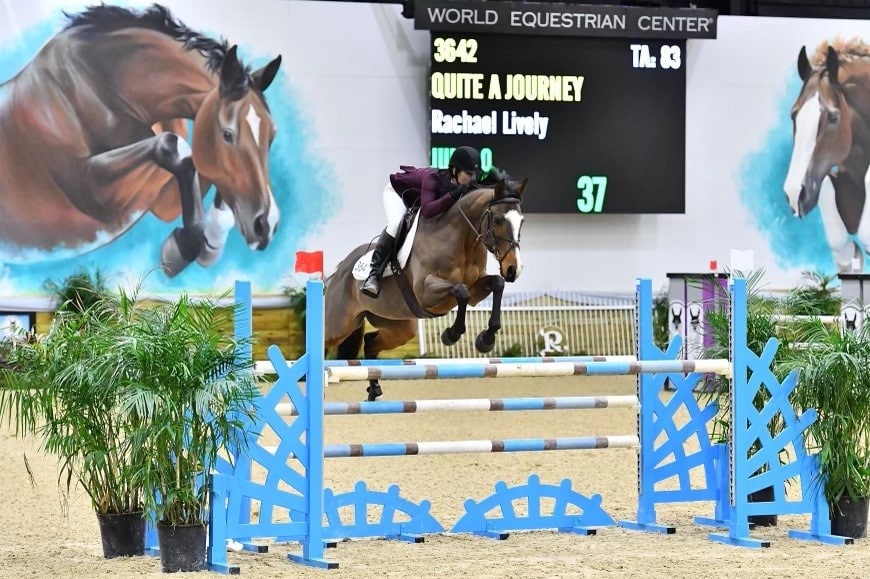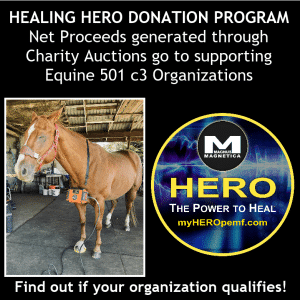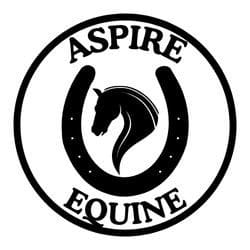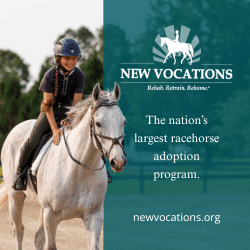Discover how the lifestyle of the steeplechase horse differs from that of a flat racer

Former Jack-Fisher-trained steeplechaser Quite A Journey has found success as Rachael Lively’s upper-level jumper. Courtesy Rachael Lively
Better Tapit had all the trappings of a star racehorse. As the offspring of Galileo mare Betterbetterbetter, whom breeder Mandy Pope had purchased for $5.2 million, and perennial leading stallion Tapit, who at the time stood for $300,000, the handsome bay colt was a hot commodity. He sold for $475,000 as a yearling and entered race training, but that’s where his star began to fizzle.
While Better Tapit never hit the board in eight starts, he did catch the eye of Debra Kachel at the 2020 Fasig-Tipton Horses of Racing Age Sale — not to continue toiling at the claiming ranks but to transition to jump racing. He won his first start over hurdles at this year’s Middleburg Hunt Point-to-Point in Virginia on May 9.
“He’s kind of disappointed his whole life until now,” says trainer Ricky Hendriks. “But he’s bred to run. When he went 21/8 miles (at the point-to-point), it was like nothing for him.”
This type of story plays out frequently in the steeplechase world. Flat racing horses’ careers inevitably begin to decline, savvy jump racing owners and trainers buy the ones they identify as promising hurdle horses and they find renewed vigor over fences.
We talked to top trainers about how they choose, condition and care for these racehorses — and what their eventual progression to sport horse is like.
Pinpointing Potential
National Museum of Racing Hall of Famer and 13-time champion steeplechase trainer Jack Fisher has an eye for a good horse. Based in Butler, Maryland, he has 30 to 40 racehorses in his care at any given time, most of which he gets from Thoroughbred sales or flat racing connections with whom he has established relationships. When assessing a horse for a jump racing career, he looks for an athlete that’s perhaps no longer at the top of its flat game but still has something to prove.
“I won’t buy something that hasn’t done anything, and I won’t buy a horse that’s over 5,” Fisher says, explaining that he gets less hesitation when asking a younger horse to run over jumps than an older one.
He also pays close attention to the horse’s flat form. “They don’t have to break their maiden, but they have to be, you know, second or third,” Fisher says. “I won’t touch a horse that trails the field.”
He cites Snap Decision (Hard Spun — Salute, Unbridled), a 7-year-old champion that has won eight in a row over jumps, as a characteristic find. The bay gelding ran in a few flat stakes races, placing third once, “but he wasn’t the winner,” says Fisher. “He just didn’t have it for the next level.”
Similarly, 2019 Thoroughbred Makeover veteran Mr. Hot Stuff (Tiznow — Sweet Damsel, Turkoman) was talented enough to earn himself a start in the 2009 Kentucky Derby but struggled to be competitive. Fisher and client Gillian Johnston bought the gelding, who went on win more than half a million over fences.
Hendriks, who is based in Unionville, Pennsylvania, and has trained the likes of Surprising Soul (Perfect Soul [IRE] — Elusive Surprise, Elusive Quality) and Optimus Prime (Deportivo [GB] — Diluvienne [FR]), Kaldoun), follows a similar formula for finding steeplechase prospects. When he goes to the sales or gets calls about flat racing horses, he looks for runners bred to go long on the turf, typically 3 to 5 years old. Better Tapit, with his turf specialist dam and distance-loving sire, fit the bill.
Teaching New Tricks
Horses go through a training and adjustment period when transitioning from flat to jump racing. While their goal remains the same — to cross the finish line first — they encounter a variety of new challenges and elements.
For example, jump horses run solely on turf. They carry weights up to 158 pounds vs. flat racing’s 110 to 130 pounds. They race distances of 2 to 3 miles, negotiating fences 3 ½ to 4 ½ feet in height. And they start at the drop of a flag rather than the opening of a gate.
A trainer’s goal, therefore, is to teach the horse to jump fences at a fast pace, then develop and maintain their stamina.
When Hendriks gets a new addition to his 20- to 25-horse stable, he turns the horse out in a round pen at his farm for a few days to relax, roll and get adjusted to the environment. Then he introduces him to poles on the ground in an arena, building up to a crossrail, then a 2-foot vertical, then the foam roll you see on the front of steeplechase hurdles. Once they’re comfortable and confident jumping in the ring, Hendriks schools his horses over rolls and small hurdles in the field.
“Sometimes you can do all this in just one day, but we usually do it in about three days,” he says. “Each horse is a little different.”
Fisher uses a trail network on his family’s 400-plus-acre property dotted with 50 to 60 logs and obstacles of different sizes to introduce horses to jumping.
“We have about 100 acres of woods, so I’ve made trails through them and start there,” he explains. “In the woods they don’t have a choice — they’re either going to jump the fence or run into a tree on either side. So that focuses them. If I just take them out into a field at first, they’ll wander left and right.”
Then he adds hurdle rolls, brush and what he calls “baby hurdles” that are 6 inches lower than race height, before progressing to national fences, the types of obstacles horses will face in most races.
Maintaining Form
Like flat racers, steeplechase horses follow an intense fitness regimen to maintain condition. Unlike in their previous careers, however, they exercise in a variety of ways on different surfaces.
For instance, Hendriks is a proponent of trotting horses on the road to strengthen their musculoskeletal systems. He says the quiet, safe lanes near his farm are ideal for periodic road work. He also takes his horses to a nearby facility for aquatic therapy in the equine swimming pool.
“The horses on the flat track, they do the same thing every day,” says Fisher. “But I try not to do the track every day. I try to mix it up.”
In addition to the hills, forest and Tapeta (silica sand, wax and fiber) track on his own property, he has access to nearly 20,000 acres of preserved county land to train on. He gallops horses in various locations to keep them mentally fresh.
Both trainers also underscore the importance of turnout, both for physical and mental fitness. Fisher says his days typically start around 6:30 a.m., when he goes horse to horse checking legs and condition. Half the horses get a couple of hours of turnout in a grass field, while the other half trains. Then they swap.
He also houses his charges in an open-aisle barn where they can watch the daily activity and socialize with other horses. “Horses are herd animals,” he says. “They don’t want to be confined to where they can’t see anybody.”
National Fence: A man-made fence used at most stops in the U.S. and in all major track steeplechasing, so named because the standard fence was developed by the National Steeplechase Association. Consists of a steel frame stuffed with plastic brush and standing 52 inches high. A foam-rubber roll, covered with green canvas, is placed on the takeoff side. Horses jump the fence in stride, much like human hurdlers in track and field events. The jumps are brought to racetracks by truck, set up a day in advance and can be taken down quickly to allow for turf racing.
Source: National Steeplechase Association
For the Love of the Horse
If there’s anything Fisher wants steeplechase newbies to know about the sport, it’s that its participants truly care about their horses.
“And I don’t think it’s just me — I think it’s everybody involved,” he says. “People that train steeplechase horses are doing it for the love of the sport.”
The sport also provides an outlet for a racehorse who, like Better Tapit, might not be living up to expectations. “It’s another good step in their career,” says Hendriks. “You never know which horse is going to surprise you. I guess that’s the fun part about training. We get them when they’re already running, and then you just never know which one’s going to turn out to be a really good horse.”
Retraining Jump Horses for Third Careers
When a steeplechase horse gets injured or his performance begins to decline, Jack Fisher says most trainers are quick to retire and rehome them.
When his great timber champion Saluter finally showed signs of slowing down, for instance, he called it quits while the horse was still healthy and sound.
“He won the Virginia Gold Cup six times in a row,” Fisher recalls. “When he finished second, at age 11, I retired him that day. When they’re not at that level, I’ll let them do something else.
“I think steeplechasing in general does a very good job of rehoming our horses once they’re no longer running,” he continues.
Fisher typically turns his retirees out to pasture for several months to a year to let down or recover from injury. When they’re ready to start their third careers, he sends them to hunter/jumper trainer Rachael Lively, of Upperco, Maryland, for retraining and placement. She takes four or five horses from Fisher a year.
“They’re a lot easier than getting a flat horse off the track to remake (which I’ve done a lot of as well) because they already have a jump and they’re pretty brave,” she says. “It’s just slowing them down and teaching them how to do it the way you want.”
Hurdle horses, for instance, are accustomed to jumping flat, because they’re not penalized for hitting jumps or grazing brush in races. Lively says she does a lot of flat work and gymnastics to teach them to be more careful and use their bodies like sport horses.
“I start with some real small gymnastics just to show them poles, because even if they ran over timber (wooden post-and-rail obstacles), they haven’t seen painted poles before, and you would not believe how terrifying that can be sometimes,” she says. “Then, after a couple of rides, I get more into the flat work. I do a lot of trot to walk just to get the trot slowed down. Most of them think they’re supposed to walk, trot superfast and strung out and gallop, and those are the only gaits they have. So there’s a couple of weeks of just teaching them that it’s fine to trot (and canter) slow.”
Lively notes that while most former steeplechase horses won’t have flawless prepurchase exams — simply from the demands of their previous racing careers — nearly all the ones she has worked with are extremely sound.
“If they held up to steeplechasing and they were happy to do it, they are pretty much going to hold up to almost anything,” she says. “You just have to give them the appropriate care.”
In her experience, former hurdle horses make fabulous event horses and competitive show jumpers. Her current upper-level jumper, in fact, is a former Fisher trainee by the name of Quite a Journey (Good Journey — Quite Beautiful, Malibu Moon). While the now 9-year-old gelding didn’t break his maiden before bowing a tendon, he’s found great success pulling double-duty as Lively’s 1.35-meter horse and her daughter’s children’s jumper.
This article was originally published in the Summer 2021 issue of Off-Track Thoroughbred Magazine, the only publication dedicated to the Thoroughbred ex-racehorse in second careers. Want four information-packed issues a year delivered to your door or your favorite digital device? Subscribe now!










